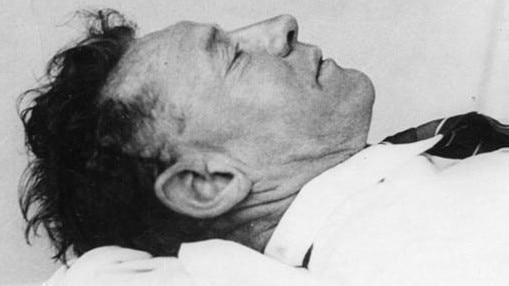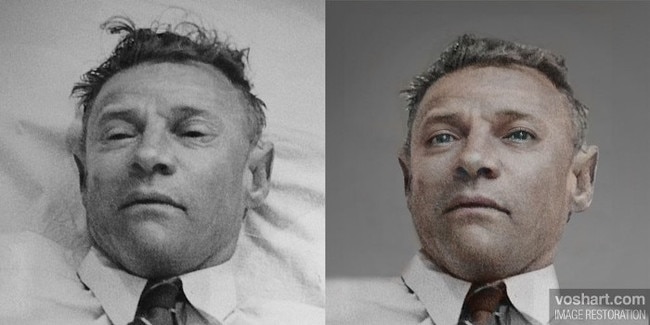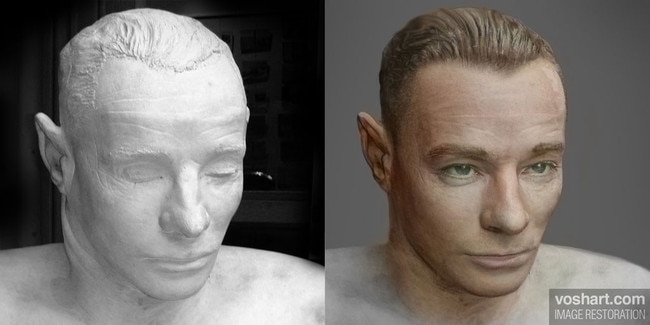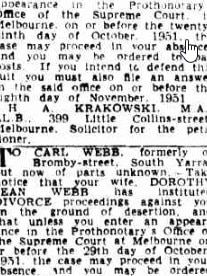New details emerge on why the Somerton Man’s wife requested a divorce
Why did the Somerton Man’s wife Dorothy really want a divorce – and then try to track him down three years after he died? Read the shocking details revealing life inside their toxic marriage.
SA News
Don't miss out on the headlines from SA News. Followed categories will be added to My News.
Details of the Somerton Man’s toxic marriage have been laid bare as it can be revealed his ex-wife tried to track him down three years after he was found dead on a South Australian beach.
In exclusive documents obtained by The Advertiser, Dorothy Jean Webb applied for a divorce on June 5, 1951, from Carl “Charles” Webb – who was this week identified as the mysterious Somerton Man.
In the documents signed by Mrs Webb, her grounds for permanent separation were “desertion”.
But case experts have warned Mr Webb’s difficult temperament may have been exaggerated to grant a divorce, which was near impossible in earlier eras.
Mrs Webb, who had moved from Victoria to Bute on the Yorke Peninsula, said her husband had “without just cause or excuse, wilfully deserted me and … left me continuously so deserted during three years and upwards”.

In the documents, Mr Webb was described as always being of moody disposition, and had called her insulting names when he was frustrated.
“Even early in our marriage, he sometimes refused to speak to me for hours on end.”
The couple were married in October 1941, lived in a flat on Bromby St in South Yarra, Victoria, until April 1947.
Mrs Webb described her husband as being aggressive when he lost his bets on horse racing or cards.


“If he lost he would be sullen and rude to me, or anyone else, if he lost at cards, he would become unpleasant to everyone,” she said.
She described him as being interested in poetry, but living a quiet life, and retiring for bed at 7pm every night.
“One night in January 1946 he told me that we were not suited to each other and would be better apart,” she said.
Mrs Webb continued to stay at their home, despite the couple sleeping in separate rooms, before she became “fearful” and left the residence.
It wasn’t until October 1951 that Mrs Webb put out an advertisement in the Missing Friends section of The Age newspaper in Melbourne in search of her husband.
The advert was printed more than three years after her husband’s body was found slumped against a sea wall on Somerton Beach, sparking the 73-year long mystery of who the man was.
In the newspaper clipping, Mrs Webb addressed Carl Webb, as “formerly of Bromby St, South Yarra, but now of parts of the unknown”.
The article was to make him aware of the divorce proceedings filed on behalf of Mr Webb, “on the ground of desertion”.

“Unless you enter an appearance in the Prothonotary’s Office of the Supreme Court at Melbourne on or before the 29th day of October 1951, the case may proceed in your absence.”
Mrs Webb was granted a divorce in April 1952.
Colleen Fitzpatrick, an American-based case expert of Identifinders International, who assisted in identifying the Somerton Man with Adelaide University Professor Derek Abbott, said the document only told half of the story.
“It’s a one-sided statement, so the man isn’t there to defend himself or to explain or say … this is what really happened,” Dr Fitzpatrick told The Advertiser.
“In a divorce, you talk to each party, and if they’re in that frame of mind they’re going to really decimate the other person.”
Dr Fitzpatrick said it was clear Mr Webb suffered mental health challenges.
“He just seemed manic depressive, he seemed he had his ups and downs of when he was rational and when he would spiral down again,” she said.
“Back then, they probably didn’t have antidepressants or anything like that, so I think back then the treatment they had was pretty bad and pretty rudimentary.
“I think he had his good days, obviously she was attracted to him, obviously they got married, there was something there.”
Following extensive DNA tests with 50 hairs obtained from a Somerton Man plaster cask by Prof Abbott, it was this week revealed that with the help of Dr Fitzpatrick he had identified the man as Carl “Charles” Webb.

Mr Webb was born on November 16, 1905, in Footscray, Victoria, to Richard August Webb and Eliza Amelia Morris Grace.
He worked as an electrical engineer and instrument maker.
Prof Abbott said he also suspected Mr Webb suffered mental health problems, and said divorces were hard to be legalised in the 1940s and ’50s which may have resulted in his personality being portrayed differently by his wife.
Before the Family Law Act of 1975 was introduced in Australia, obtaining a divorce was a complicated process, including having to establish a “ground” for a divorce.
Among the acceptable “grounds” included adultery, desertion, cruelty, habitual drunkenness, imprisonment, or insanity.
A couple had to be separated for five years for a divorce to be granted.
“She did beat it up, he doesn’t sound nice – but who sounds nice in a divorce? So I think you really do have to take it all with a pinch of salt,” Prof Abbott said.
Prof Abbott said Mr Webb endured a lot of hardship in a short space of time, including that his father died in 1939, and his nephew and brother died during the war.
His mother also died in 1946.
DNA work is currently being undertaken by SA Police with Forensics SA after the Somerton Man’s remains were exhumed from the West Tce Cemetery in May last year.
In a statement earlier this week, an SA Police spokesperson said they were “cautiously optimistic” about the identification by Prof Abbott and Dr Fitzpatrick.
“We look forward to the outcome of further DNA work to confirm the identification which will ultimately be determined by the Coroner,” they said.




